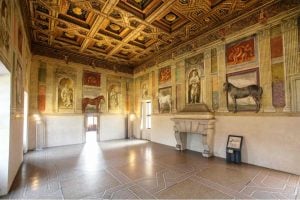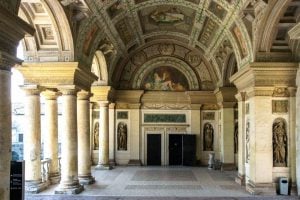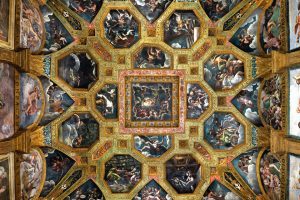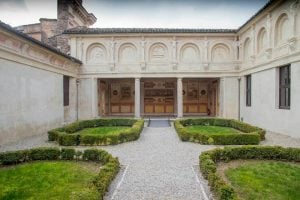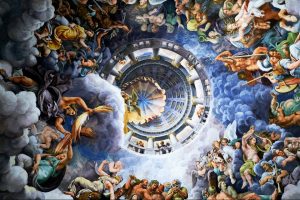The southern part of Palazzo Te centres around the painting of the Giants, who are desperately attempting to conquer the mount Olympus. It is an allegory of the pointless rebellion of the enemies of Carlo V and of the Empire. The frescoe creates a particular atmosphere, highlighting the cave-like appearance of the room that is similar to a grotto or an ancient tomb.
Loggia of David
A place where all paths cross: the loggia opens up to the garden on one side, on the other it gives onto the cour d’honneur. It was admired by Charles V during his second visit to Mantua in 1532. The protagonist of the scenes decorating the loggia is not a legendary figure but a character from the Old Testament. He is both the captain defending Israel and the young hero defeating Goliath, who is in love with the beautiful Bathsheba. The frescoes are the work of various painters: Luca da Faenza, Rinaldo Mantovano, Fermo da Caravaggio, Benedetto Pagni. Worthy of note are also the stuccoes and the sculptures representing the Virtues, which date to the seventeenth century.
From the loggia we pass into the sunny garden, enclosed by an exedra, that dates to a different period. The style of the Loggia is inspired by the prototype of the Roman villa created by Raphael. This place had a series of different functions: it was a place for recreation, it was meant to glorify the Prince; furthermore it was the ideal place to stage theatrical performances; finally it is the place that best sums up and represents the whole Palace. Here the rhythm created by the frescoes and the decorations respond to the complexity of the architecture.
Chamber of the Stuccoes
Passing through the Loggia of David the visitor enters a rectangular space that is decorated by stuccoes representing divinities and scenes from ancient Rome. The work is by Francesco Primaticcio, one of the collaborators of Giulio Romano, who was here assisted by Giovan Battista Mantovano. The artist also contributed to the realization of the frescoes of Fontainebleu in France. The stuccoes are divided between the barrel vault, divided into twenty-five squares, and the double area of friezes that delimits it. A curious detail: one of the scenes is a baptism, out of context with respect to the other classical scenes represented. The reference is to an episode of Roman history narrated on Trajan’s Column and on the Column of Marcus Aurelius in Rome. The intention of Giulio Romano was to glorify the classical word by surprising the visitor with the great many characters represented in the scenes.
The beauty of this impressive vault lies in the chromatic contrast between the white figures and the black background, creating something that looks like an ancient cameo. The past is evoked through the illusions that here speak of the present glory.
The detail of this double strip shows a parade of armed men, and the legs of horses that seem to come out of the wall. In the lower part, to the left, it is possible to recognize the Emperor on his horse leading the men, his arm raised, to lead the way. The second artistic reference of Giulio Romano is perhaps the painting depicting the great triumph with which Andrea Mantegna had adorned, a couple of decades earlier, the Palazzo di San Sebastiano. The same scene here acquires a plastic quality, and the figures, less dynamic than their painted counterparts, are turned into emblems.
A detail of one of the frames, the stucco here represents two armed men who are about to fight.
Chamber of the Emperors
Before the Hall of the Giants, we pass through the Hall of the Emperors, glorification of the greatness of ancient Rome, ideally preceded by the achievements of Alexander the Great, who is represented with his father Philip II of Macedon next to Julius Caesar and Augustus. It is not certain whether Primaticcio and Rinaldo Mantovano are the authors of these frescoes. Next to the four sovereigns there are two tondoes, which illustrate the virtues of a just ruler.
At the centre of the vault, enriched by a light blue and red decoration in stucco with vegetal motifs, there is a central square which shows a painting of Caesar who is ordering the destruction of the letters by Pompey. Also here the main theme is the magnanimity of the ruler. By destroying these letters, Caesar was preventing Pompey’s plots against the state from becoming public, so that the memory of his defeated enemy would be, at least in part, preserved.
In the frescoed tondo Alexander the Great holds a precious box, war booty, inside which the things most precious to him are kept: a copy of the Iliad and one of the Odyssey. It is the duty of a ruler to foster art and culture so they may remain alive throughout history.
Chamber of the giants
A marvellous art work that still today fascinates visitors: the Hall of the Giants, a room made to look like a cave, is decorated with representations of monstrous creatures waging an attack on the Mount Olympus and the heavens. Jupiter is fighting to defend his children. Giulio Romano turned the vault into a sky, with a series of not concentric circles. The perspective reaches a climax, something that was later imitated by many artists, with a canopy under which stands the throne of the king of the gods. Significantly it is empty, although there is an eagle that represents both Jupiter and the empire. The entire representation also has a political meaning, in that it alludes to the triumph of Charles V and the defeat of his enemy. It is interesting to see how the painter, probably Rinaldo Mantovano, creates a chaotic and indistinct crowd of divinities, almost hidden behind the white clouds, frightened by the march of the Giants who are about to fall, hit by lightening.
In a curious but coherent way, the sky ends behind Jupiter’s canopy just as a vault would. The heavens are closed, in a manner that is characteristic of Giulio Romano’s art, that combines an invented reality with an artificial space. The twelve columns, almost hidden by a cloud, support the imaginary part of the cupola and trace another circle, a third one with respect to the one formed by the clouds and the one created by the canopy. The result is a celestial chart, that the Giants intend to destroy.
The Giants, colossal figures painted as hungry peasants intent on lifting the mounts and throwing them against the cupola of the rulers, appear in many places of the painting, being at the same time buried under the rocks they are trying to upturn. The story illustrates mythological episodes taken from Latin literature, but what is important here is the dynamism of the scene, that translates the violence of the rebels into a continuous rotating movement: the Giants are destined to fall into the bowels of the earth.
The architecture of the upturned universe falls onto the rebels, signifying the defeat of irrationality and of blind fury.
Chamber of the Grottesche
The small Chamber, also known as the eight sided chamber, is decorated with lively grotesques which represent small figures painted in a vegetal context. The main author of the work is Luca da Faenza, while the stuccoes are the work of Andrea de Conti.
The play of small Cupids inside a plaque with a dark background, held up by other Cupids.
Chamber of the Candelabra
The freize in this room is the only work that dates to the period of Giulio Romano; the authors are Nicolò da Milano and Giovan Battista Mantovano. It is the usual classical representation of prisoners, army trophies and bacchic scenes. The distribution of the space of the frieze, decorated with tondoes and squares, is complex.
The decoration of the wooden coffered ceiling that dates to the Sixteenth century, is the work of Staffieri who realized it in 1813.
Chamber Of The Victories
The name derives from the winged Victories portrayed in the corners of the room together with two symbols of Fame bearing long trumpets.
The frieze comprises elegant painted grotesques on a background of imitation semi-precious stones, as described in a contemporary document. Oval partitions contain stucco crosses with clipeate busts, also in relief.
The stuccoes are attributed to Nicolò da Milano, while the paintings are by Agostino da Mozzanica. The overall decoration of the room can be dated 1528. This is confirmed by the absence of the mount Olympus device in the Gonzaga coat of arms in the centre of the ceiling. This appears only after 1530.
The decoration of the ceiling is particularly worthy of note: in an example unique in the palazzo the wooden coffers are decorated with scenes of daily life seen from below, in clear reference to Mantegna’s Bridal Chamber at the Ducal Palace.
An elderly woman picking fleas out of a child’s hair, a woman hanging out a shirt, a young woman combing her hair and, in a direct reference to Mantegna, another approaching a vase of carnations on the balcony.
Palazzo Te
The Palazzo Te is a historic and monumental building in Mantua. a fine example of the mannerist style of architecture, Built between 1524 and 1534 on commission by Federico II Gonzaga, it is the most famous work of the Italian architect Giulio Romano. The complex is now home to the civic museum and, since 1990, the International Center for Art and Culture of Palazzo Te which organizes exhibitions of ancient and modern art and architecture.

